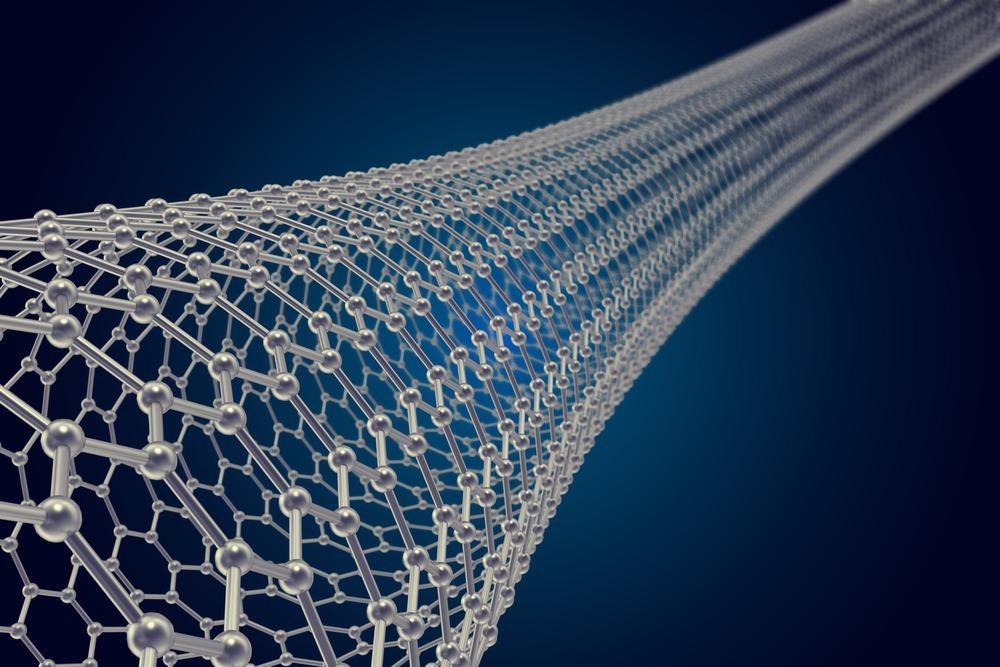According to a study published in the journal Nano Letters, a group of researchers used an electron-beam-induced self-assembly approach to generate thin curved nanotubes for the implementation of nanofluidic sensors.

Study: Realization of Curved Circular Nanotubes Using In Situ Monitored Self-Assembly. Image Credit: Rost9/Shutterstock.com
In the field of genetics, biochemistry, and pharmacology, curved microfluidic pathways with a circular cross-section play a significant function. However, in nano-fluidics, the absence of a viable production process for curved spherical nanotubes (10-1000 nm) remains mainly unaddressed.
An atomic layer coating procedure might be used to regulate the tube's size accurately.
In the study, using a backscattering microscope and an optic dispersion limit size, fluid carried via the nanochannels was validated and described.
The flow rate indicated that evaporation of the fluid in the nanochannel produces condensed vapor, which propels and forces the liquid ahead, resulting in a directed flow behaviour in tubes with a radius of 100 nm. This phenomenon might serve as a foundation for the creation of a variety of nanofluidic devices.
Importance of Curved Microchannels
Because they enhance the practical path length in the direction of flow, curved (orbit on x-axis or y-axis) microchannels have been widely researched. A curved microchannel simultaneously creates an angular momentum, which causes a longitudinal flow pattern, which is important for cell segregation, dynamic blending, and objective particle entrapment.
Unique Characteristic of Nano-channels
Because of its smaller size range, the curved nanochannel, unlike the microchannel, has various distinguishing characteristics, including better energy efficiency, molecular bonding, and ion mobility. Furthermore, eliminating the edge effect that causes non-uniform tension gradients at the channel's vertices is possible if the channel cross-section is spherical rather than the conventional rectangular type found in most micro and nanofluidic channels.
Here, non-uniform pressure increases, causing biological material to accumulate towards the border rather than being distributed evenly.
The spherical cross-section also reduces shear force on biological material passing through the channel (cells or DNA). For these characteristics, nanosized circular tubes may be used in vital scientific domains, including DNA sample and investigation, virus scanning, and complex molecular characterization.
Limitations of Current Methods to Fabricate Circular Tubes
Several methods for making spherical tubes have been documented, including elastic fiber, silicon olefins, and melted photographic templates. However, these approaches were solely designed for microscale and macroscale channels.
Since typical lithography processes are dependent on parameterization, which results in rectangular cross-sections, it is exceedingly difficult to create spherical tubes at the nanometer scale, in contrast to macro-and microscale sizes.
Grey-scale lithography also prevents the production of cylindrical sidewalls on a scale of a few hundred nanometers.
Strain Induced Self-Rolling Process
A strain-induced self-rolling procedure has been demonstrated to generate a new category of straight spherical nanotubes using a robust, repeatable, and wafer-scale production approach.
When the protective film is deliberately wet-etched beneath, the mismatched matrix between two layers creates a tension that causes self-rolling up from the substrate. This method allows for the fabrication of nanotubes with diameters ranging from 20 nm to 1μm for applications such as fluid transfer and semiconductor device implantation. But again, the limitation is that this method only produces straight nanotubes, not curved ones.
A Way to Produce Curved Circular Nanotubes
The researchers in this study described a method for fabricating curved (arc) spherical nanotubes with a radius of 10-100 nm employing an in situ controlled self-curving technique, which provides useful imaging and strong maneuverability of the self-assembly at the nanoscale.
The in situ controlled self-assembly approach also offers a revolutionary method for flawless bonding at the nanoscale, joining several nano-pieces to produce nanotubes.
Dark-field microscopy equipment was used to verify the sealing state and fluid circulation in nanotubes with a radius of under 100 nm. This research suggested approach will serve as a valuable foundation for creating a variety of nanofluidic devices.
Research Findings and Conclusion
According to this research, an electron (e-) beam-based self-assembly technique was used to establish a manufacturing strategy for a curved spherical nanotube with a radius of 100 nm.
SEM allows for nanoscale precision control when converting 2D designs into 3D curved nanotubes with a flawless circular cross-section.
Using an ALD method, the radius of the nanotubes can be reduced to 10 nm with an accuracy of 0.1 nm.
Even though the established e- beam-induced self-curving technique has complexities that limit its wide scale integration, the methodology demonstrated will spotlight a strategy for manufacturing both curved and normal spherical tubes below 100 nm scale with rapid customizable tube size.
Here, an attractive addition for nanofluidic research has been obtained. Furthermore, the new fluid flow created by a self-pumping mechanism might spark a wide range of applications in nano-devices that need mechanical energy or force.
Continue reading: Diagnosing Ovarian Cancer with Carbon Nanotubes.
Reference
Zihao Lin. et al. (2022). Realization of Curved Circular Nanotubes Using In Situ Monitored Self - assembly. Nano letters. Available at: https://pubs.acs.org/doi/10.1021/acs.nanolett.1c04093#
Disclaimer: The views expressed here are those of the author expressed in their private capacity and do not necessarily represent the views of AZoM.com Limited T/A AZoNetwork the owner and operator of this website. This disclaimer forms part of the Terms and conditions of use of this website.